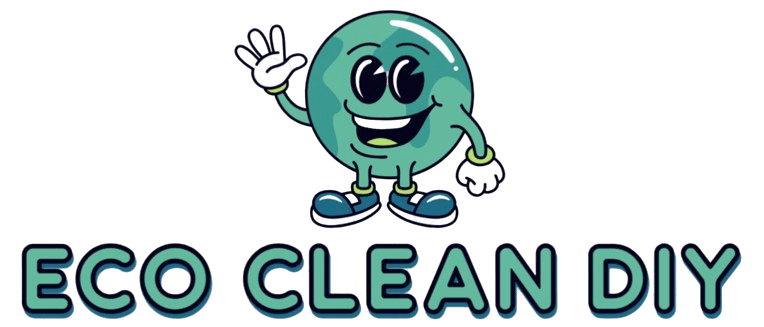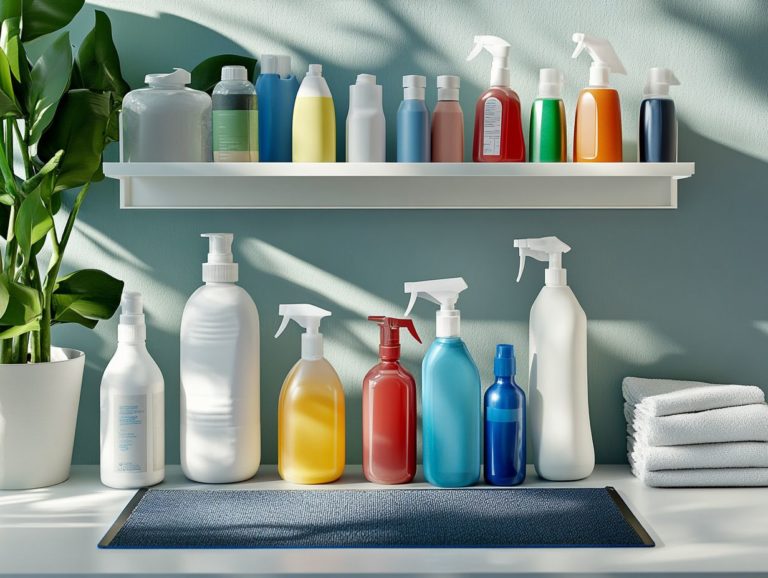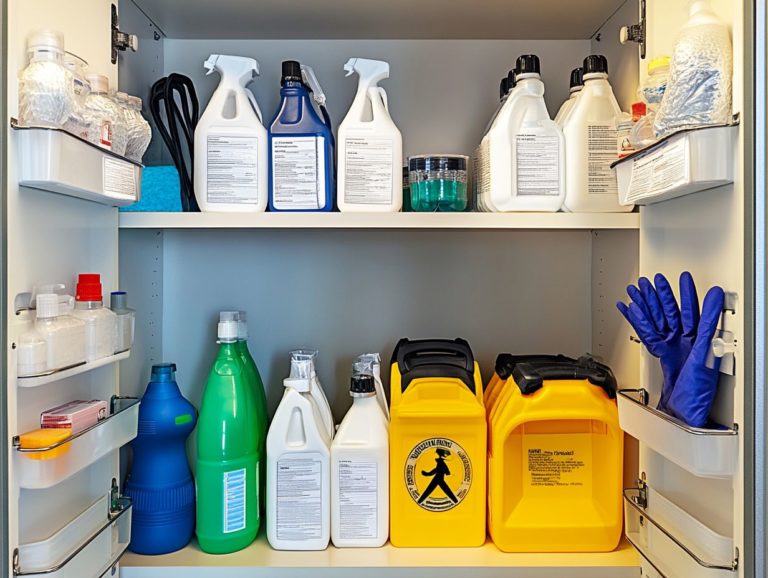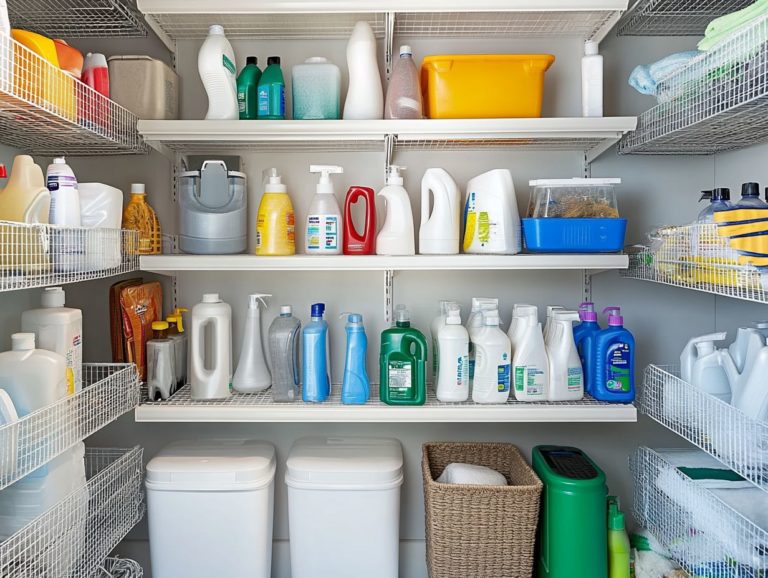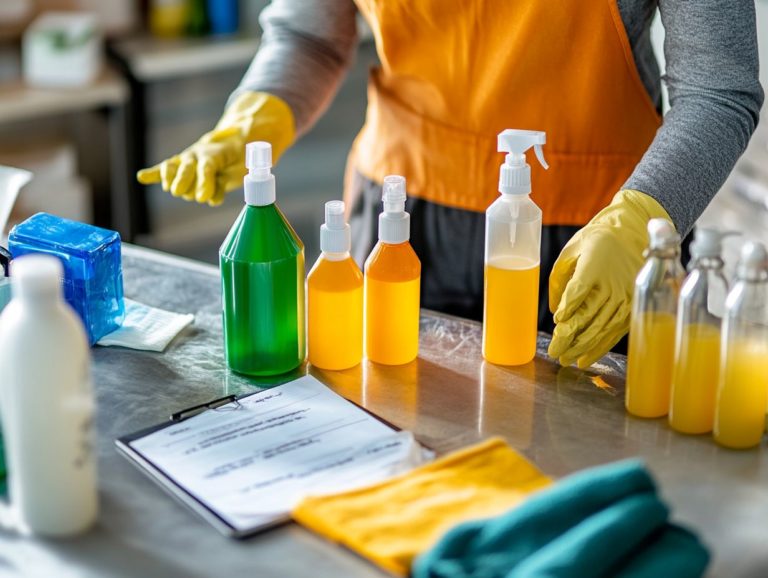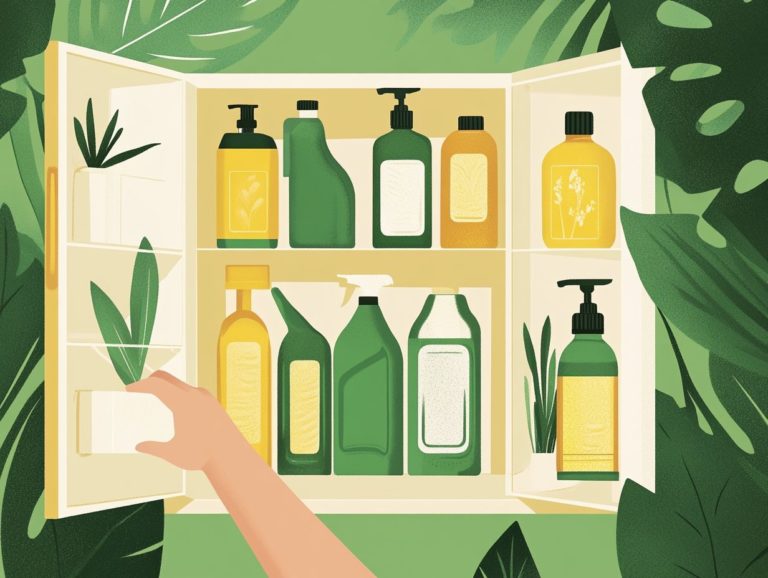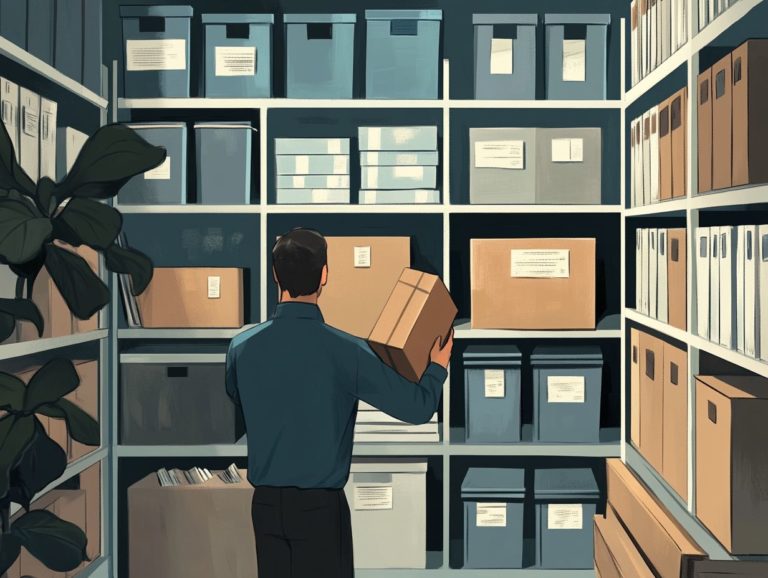Essential Safety Tips for Storing Cleaners
Proper storage of cleaners is essential for safety and effectiveness in any setting. This includes both homes and industrial environments.
Implementing proper storage solutions can significantly reduce risks associated with cleaning supplies and chemicals. With many types of cleaners at your disposal household, industrial, and natural understanding the correct storage methods helps you avoid mixing chemicals and reduces exposure to toxic fumes.
It’s important to seek guidance from the American Cleaning Institute and follow safety guidelines for proper chemical storage. Let s explore the importance of safe storage together.
This guide categorizes the different types of cleaners, offers practical tips to ensure your cleaning products remain effective while minimizing risks, and highlights the importance of regular checks and updates to stay current with safety protocols.
Discover how to cultivate a safer environment for yourself and your loved ones while learning effective baby-proofing and toddler safety techniques.
Contents
- Key Takeaways:
- Why Is Proper Storage of Cleaners Important?
- Types of Cleaners You Should Know
- What Are the Risks of Improperly Stored Cleaners?
- How Should You Store Household Cleaners?
- Essential Tips for Safely Storing Industrial Cleaners
- What Are Some Additional Safety Tips for Storing Cleaners?
- Frequently Asked Questions
Key Takeaways:
- Proper storage of cleaners is crucial to avoid chemical reactions, inhalation of toxic fumes, and fire hazards. Implementing child-proof locks and using child-resistant lids are essential for ensuring child safety.
- Household, industrial, and natural cleaners all require specific storage methods and should never be mixed. High and secure storage practices are vital to prevent unauthorized access and accidental exposure.
- Keep cleaners out of reach of children and pets, use proper containers and protective gear, and follow label instructions and safety data sheets. Adopting organization systems and proper disposal methods can further enhance safety.
Why Is Proper Storage of Cleaners Important?
Enacting a chemical safety program and adhering to safety training are crucial for the proper storage of cleaning supplies. Secure storage is essential for household safety, especially when children are around.
Be vigilant about the potential dangers posed by hazardous chemicals in common cleaning products. Improper storage can lead to accidental exposure, which might have serious health repercussions.
Recognizing the significance of secure storage solutions and following safety guidelines, including child safety measures and baby-proofing, can significantly mitigate the risks associated with chemical exposure. This creates a safer environment for your children to thrive in.
Types of Cleaners You Should Know
Understanding the various types of cleaners available is crucial for effective cleaning practices while prioritizing safety in your home. Cleaners can be broadly classified into three categories: household cleaners, industrial cleaners, and natural cleaners, each with distinct formulations and intended uses.
Household cleaners cater to everyday cleaning needs, making light work of routine tasks. In contrast, industrial cleaners are tailored for more demanding applications, tackling the toughest messes with power and precision. High and secure storage are necessary for both types to ensure safe handling and accident prevention.
If you prefer an eco-friendly route, natural cleaners offer a sustainable alternative, harnessing biodegradable ingredients to reduce both chemical exposure and environmental impact.
Take steps today to secure your cleaning products and protect your loved ones!
1. Household Cleaners
Household cleaners are specifically formulated solutions designed to tackle various surfaces and items throughout your home. They include versatile all-purpose sprays and targeted products for kitchens and bathrooms.
While these cleaners are undeniably effective, they can harbor hazardous chemicals that pose risks to children if accessed or misused. Therefore, it s essential to ensure proper storage, clear labeling, and to consult safety data sheets (documents that provide safety information about cleaning products) for guidance on safe handling.
Understanding the different types of household cleaners is vital for safety. For example, bleach-based products excel at disinfecting. However, they can emit harmful fumes if not used correctly.
Similarly, solvents in glass cleaners can pose fire hazards if they re stored too close to heat sources. The importance of meticulously reading ingredient labels and following the manufacturer’s instructions cannot be overstated.
Implementing safe storage practices, such as placing cleaners in locked cabinets, plays a crucial role in preventing accidents. Exploring environmentally friendly alternatives can significantly reduce your exposure to these potentially dangerous chemicals.
Ultimately, this fosters a healthier atmosphere for everyone in your household.
2. Industrial Cleaners
Industrial cleaners are robust formulations designed for commercial environments, adept at tackling the most challenging cleaning tasks. These products are specifically engineered to penetrate and dismantle stubborn grime, grease, and stains that often plague manufacturing facilities, warehouses, and laboratories.
Their potency stems from a sophisticated blend of solvents, surfactants, and acids, all targeting and dissolving contaminants that ordinary cleaners frequently miss. Regular safety protocols and cleaning techniques can help mitigate the risks associated with these powerful cleaning chemicals.
While their efficacy is beyond question, it s crucial to recognize the potential risks tied to mishandling these powerful products. Neglecting safety can result in serious health hazards, such as respiratory issues and skin irritation.
That s why it s vital to wear the appropriate protective gear, like gloves and masks, and adhere strictly to established guidelines to ensure safe usage and minimize exposure. Proper storage practices are essential to avoid unauthorized access and accidents.
This highlights the importance of maintaining a vigilant and proactive approach to managing industrial cleaners.
3. Natural Cleaners
Natural cleaners present an eco-friendly alternative to conventional cleaning products, often crafted from biodegradable ingredients that significantly reduce harmful chemical exposure. These formulations are designed to minimize their environmental footprint while excelling in household cleaning tasks.
This makes them particularly appealing for parents who prioritize the safety and health of their children. Be sure to label and store them properly to keep your home safe from accidental exposure.
You might find solace in knowing that these natural solutions can alleviate concerns about indoor air pollution and health risks, especially for sensitive individuals. While many natural cleaners perform admirably against dirt and germs, they may not always tackle tough stains or stubborn bacteria as effectively as their conventional counterparts.
Consulting with professionals in the cleaning industry can provide additional insights into effective cleaning practices and products. Talk to cleaning experts for the best advice!
Considering the environmental impact of sourcing specific natural ingredients is crucial, as not all are sustainably harvested. Assessing these factors is vital for those who seek a harmonious balance between safety, effectiveness, and environmental responsibility.
Organizations like the National Poison Control provide useful resources on chemical safety and proper disposal methods.
What Are the Risks of Improperly Stored Cleaners?
Improperly stored cleaning supplies present considerable risks that can compromise the safety and well-being of both children and adults. The dangers include accidental exposure to hazardous chemicals, which could result in serious health issues such as poisoning, respiratory problems, and even fire hazards.
It s crucial to recognize the potential threats associated with inadequate storage. Take proactive steps to safeguard your loved ones by implementing effective safety measures, including following proper storage guidelines and establishing emergency procedures. This is essential to ensure a secure environment for everyone in your household.
1. Chemical Reactions
Chemical reactions can occur when you mix cleaning products that shouldn t be mixed, potentially leading to dangerous fumes or reactions that can harm those nearby. It’s essential to store your cleaning supplies according to safety data sheets and resist the urge to combine different types of cleaners.
Improper handling can spark volatile reactions that pose serious health risks. Understanding the compatibility of various cleaning agents is crucial for maintaining safety in both your home and workplace. Many cleaning products contain chemicals that can create dangerous fumes or cause corrosive reactions when combined, damaging surfaces and endangering individuals.
Keeping a risk assessment updated and consulting poison control in case of exposure can be lifesaving measures. Safety data sheets are your best friends in this scenario, providing detailed information about hazardous substances, including safe handling practices and recommended storage conditions.
By familiarizing yourself with these guidelines, you’ll be enabled to make informed decisions about the products you use together. Keeping your cleaning supplies organized is also important to prevent any accidental mixtures that could lead to harmful consequences.
2. Inhalation of Toxic Fumes
Inhaling toxic fumes from improperly stored or mixed cleaning products can lead to serious respiratory issues and a host of other health problems. Ensuring proper ventilation is essential whenever you use these cleaners to mitigate the risks associated with chemical exposure.
It’s crucial for parents to remain vigilant about the potential dangers these products pose. Implement safety precautions to protect children from harmful fume inhalation.
The consequences of exposure can be particularly severe for vulnerable populations, such as young children and those with pre-existing health conditions. To further reduce these dangers, it s imperative to handle cleaning products in well-ventilated areas, allowing fresh air to circulate and disperse any harmful vapors.
Utilizing exhaust fans, opening windows, and wearing protective gear can significantly minimize health hazards. Storing these chemicals safely, away from living areas and out of reach of children, is of utmost importance.
Incorporating organizational systems for proper disposal and ventilation can further enhance safety. By adopting these straightforward yet effective strategies, you can create a safer environment in your home and greatly reduce the likelihood of respiratory complications or other serious health issues caused by toxic fumes.
3. Fire Hazards
Many cleaning products contain flammable materials that can pose serious fire hazards if not stored properly. Be mindful of where you store cleaning supplies; it can prevent dangerous fires! Ensure they are tucked away from heat sources and stored in appropriate containers to minimize any risk of fire.
Implementing safety measures, such as conducting regular checks and adhering to proper storage guidelines, can significantly help prevent dangerous situations and ensure household safety. Keeping these products out of direct sunlight and extreme temperatures is crucial.
It’s also wise for you and your family to understand the specific fire hazards associated with the chemicals in your household cleaners. Common items like aerosol sprays, solvents, and certain concentrated cleaners can ignite unexpectedly if mishandled.
Maintaining an organized cleaning supply area complete with clearly labeled containers and proper storage solutions will allow for quick access during emergencies. By understanding product labels and following the instructions, you’re promoting a safer environment. You’re also ensuring that everyone in your household can navigate their cleaning routines confidently and safely, thus enhancing overall home safety.
Check your storage practices immediately and implement these recommended safety measures to protect your loved ones.
How Should You Store Household Cleaners?
Storing household cleaners safely is essential for preventing accidental exposure, especially in homes with children. Take key steps to ensure that cleaning products and hazardous chemicals are out of reach.
- Consider using child-proof locks on cabinets to enhance child safety.
- Place any hazardous supplies on high storage shelves.
Transform your home into a safe haven today by following these proper storage guidelines. This will not only give you peace of mind but also reduce potential dangers.
1. Keep Out of Reach of Children and Pets
To ensure household cleaners remain safe, store them out of reach of children and pets. Utilizing child-proof locks on storage cabinets is a smart move to safeguard hazardous materials. This step provides peace of mind that your little ones won t stumble upon potentially harmful products, thereby improving toddler safety.
Organizing your cleaning supplies in high cabinets or high storage shelves further minimizes the risk of accidents, making these items less accessible. Use clear, labeled containers for each type of cleaner to easily identify what s safe and what should stay locked away.
Installing shelving units well above a child’s reach not only keeps these items secure but also optimizes your space. Regularly review the contents of these storage areas to ensure that expired or unused products are disposed of properly, maintaining a safer home environment and enhancing overall home safety.
2. Store in Original Containers
Storing cleaning products in their original containers is crucial for safety and proper handling. These containers have clear labeling that includes essential safety information, usage instructions, and emergency procedures. This makes it easier to manage these products responsibly and effectively, ensuring safe handling and proper disposal.
Labels provide vital details such as first aid measures in the event of accidental exposure, which can be invaluable during emergencies. Safety data sheets included with these products outline potential hazards and necessary precautions when using cleaning substances, giving you clear guidance.
By keeping products in their original vessels, you can avoid the risks associated with mixing chemicals or misusing products, which could lead to hazardous situations. Following these practices cultivates a safer home environment and encourages responsible use of cleaning agents, allowing you to maintain a clean space with confidence. This approach aligns with guidelines set by safety organizations like the American Cleaning Institute.
3. Follow Label Instructions
Following label instructions is absolutely crucial when using and storing cleaning products. This practice ensures safe handling and helps prevent accidental chemical hazards and other potential dangers. Each product label contains vital information about proper usage, precautions, and storage recommendations that you must follow to maintain a safe home environment.
Neglecting these directives can lead to dangerous situations, such as accidental poisoning, chemical burns, or creating toxic fumes from incompatible substances. For example, mixing bleach with ammonia is a common blunder that can produce harmful gases and pose serious health risks. Always refer to the guidelines issued by poison control authorities like the National Poison Control Center.
Stay vigilant now to protect your loved ones! Educate yourself about the intricacies of cleaning product use not just for your well-being, but also for the safety of your children and pets. By prioritizing adherence to label instructions, you can significantly reduce the potential for accidents and create a cleaner, safer space free from hazardous materials, promoting household safety.
Essential Tips for Safely Storing Industrial Cleaners
Storing industrial cleaners safely is crucial given their powerful formulations, which can present significant risks if not handled with care. Always keep these cleaners in a well-ventilated space, away from heat sources and any incompatible substances, to minimize the potential for accidents and ensure proper ventilation.
Use containers specifically designed for chemical storage to guarantee safety and effectiveness. Follow the guidelines in safety data sheets documents that provide safety information about chemicals to assess risks and ensure safe handling practices.
1. Store in a Well-Ventilated Area
Store industrial cleaners in a well-ventilated area to mitigate risks associated with chemical exposure. Proper ventilation disperses harmful fumes and prevents accidental spills from escalating into hazardous situations. This is a key aspect of safety when handling powerful cleaning products.
Reduce risks by using appropriate storage containers that are compatible with your specific cleaners. Ensure that airborne toxins are effectively removed from the area, maintaining an optimal concentration of fresh air. This is crucial for any chemical safety program.
This practice enhances workplace safety and aligns with workplace health standards. A strategic approach to ventilation decreases respiratory issues and health-related concerns, fostering a safer and more productive working environment for everyone involved.
2. Use Proper Containers
Using the appropriate containers for industrial cleaners is essential to prevent leaks, spills, and unintended reactions. These containers should be designed for chemical storage and clearly labeled with safety information. This ensures that everyone handling these products is aware of the associated hazards and necessary safety protocols.
Following safety guidelines creates a strong safety culture in your organization. By opting for containers suited for chemical storage, you can significantly minimize the risk of accidents, protecting both human health and the environment. Hospitals, especially, benefit from stringent chemical safety protocols.
Implement a consistent labeling system for quick identification of substances, ensuring that safety measures are followed even under pressure. This proactive stance safeguards employees and aids in maintaining regulatory compliance, helping you avoid costly legal repercussions and potential damage to your reputation.
3. Follow Safety Data Sheets
Make it a priority to follow safety data sheets (SDS) for handling industrial cleaners. These documents contain critical information about chemical hazards, safe usage practices, and emergency procedures. By adhering to SDS guidelines, your company can establish effective chemical safety programs that protect employees and reduce the risk of accidents, promoting a safer work environment.
These sheets are essential resources, detailing the composition and potential risks of each chemical, along with necessary personal protective equipment and first aid measures for exposure. A thorough understanding of SDS helps your organization comply with regulatory requirements, fostering a workplace culture that emphasizes safety.
Don’t wait regularly review safety data sheets to keep your team safe and informed! Regular training sessions based on this information ensure your employees are well-prepared to handle these substances responsibly. This commitment contributes to a safer, more efficient operational environment while minimizing hazardous incidents.
What Are Some Additional Safety Tips for Storing Cleaners?
In addition to proper storage practices, it’s crucial for parents and caregivers to follow several key safety tips to ensure the safe handling of cleaning supplies and childcare safety.
You should avoid mixing different types of cleaners. Doing so can create dangerous reactions.
Wearing protective gear when necessary is also wise, protecting yourself during cleaning tasks. Following these guidelines can significantly reduce the risk of chemical exposure.
It’s important to dispose of unused or expired cleaners in an appropriate manner to mitigate risks. By adhering to these guidelines and utilizing proper storage with child-proof locks, you can help maintain a safe environment for both children and pets.
1. Do Not Mix Different Types of Cleaners
Never mix different types of cleaners! This can trigger dangerous reactions, creating toxic fumes or even explosions. This precaution is vital not only for your safety but also for anyone else nearby, including toddlers and children.
For instance, when you mix bleach with ammonia, you generate chloramine vapors, which can lead to respiratory problems and symptoms like coughing and chest pain.
Similarly, while combining vinegar with baking soda might create a mild reaction, mixing it with certain commercial cleaners can release harmful gases that pose serious health risks. Always ensure to follow safety guidelines and labels on cleaning supplies to avoid these potential dangers.
Being aware of safe cleaning practices not only ensures a healthier environment at home but also safeguards your personal health and well-being. Participating in safety training and staying informed about the latest safety protocols can be beneficial.
2. Wear Protective Gear
Wearing protective gear when handling cleaners is an essential safety measure that helps you prevent chemical exposure and potential injuries. This gear might include gloves, goggles, and masks, depending on the cleaning supplies you re using and the associated risks.
It s your safeguard against harmful substances during cleaning tasks, ensuring safe handling and minimizing the chances of chemical hazards.
Choosing the right protective gear is essential, especially when you’re dealing with harsh chemicals like bleach, ammonia, or industrial-strength cleaners. For example, durable nitrile gloves are a must to protect your skin from irritants, while safety goggles shield your eyes from splashes and fumes that could lead to serious injuries.
If you re working with harmful chemicals released into the air from some cleaning products, respirators or masks become necessary, as inhaling these substances can pose significant health risks. Following a chemical safety program can help you stay prepared for any emergency procedures.
Ultimately, selecting the right protective gear not only ensures your personal safety but also fosters a healthier cleaning environment for everyone involved. Make sure to consult safety data sheets for more detailed information on the necessary protective equipment.
3. Dispose of Unused or Expired Cleaners Properly
Properly disposing of unused or expired cleaners is essential for preventing chemical hazards and ensuring the safety of your household. By adhering to local regulations regarding hazardous waste disposal and following established safety guidelines, you effectively mitigate the risks associated with improperly discarded cleaning products, safeguarding both yourself and the environment.
Consulting with poison control centers and hospitals for advice on disposal can also be beneficial. Cleaning supplies often contain volatile compounds, which are chemicals that can easily evaporate and cause harm if they leak into soil or water. It s crucial to learn about your local waste disposal rules, as many communities provide designated drop-off locations or collection events specifically for hazardous materials.
Proper disposal techniques, such as using storage cabinets for hazardous chemicals, can help minimize these risks. When it comes time to dispose of these substances, using their original containers with labels intact aids in identification and significantly reduces the chance of accidental exposure.
Taking safety precautions, like wearing gloves or a mask during the disposal process, can further protect your personal health. Clear labeling and organization systems for chemical storage can also play a crucial role in safe disposal practices. Being diligent not only keeps you safe but also creates a cleaner environment for everyone.
This level of diligence ensures compliance with legal obligations and contributes to a cleaner, safer environment for your community and beyond. By following these safety measures, you reduce the risk of chemical exposure and enhance overall household safety.
Frequently Asked Questions
How Can You Store Cleaners Safely?
- Keep cleaners out of reach from children and pets by using child-proof locks and high storage to avoid accidental ingestion or exposure.
- Always store cleaners in their original, labeled containers to prevent confusion and misuse. Child-resistant lids can also add an additional layer of safety.
- Store cleaners in a well-ventilated area to avoid inhaling harmful fumes. Proper ventilation minimizes the risks associated with chemical exposure.
- Keep cleaners away from direct sunlight or heat sources, as they can be flammable and cause explosions. Handle flammable materials with extra caution to ensure home safety.
- Never mix different types of cleaners together, as they can create toxic fumes.
- Properly dispose of old or expired cleaners following local regulations. Utilizing organization tips from the American Cleaning Institute can also aid in efficient and safe disposal.
Don’t wait! Learn your local waste disposal rules today and ensure your cleaning supplies are stored safely and disposed of properly.
